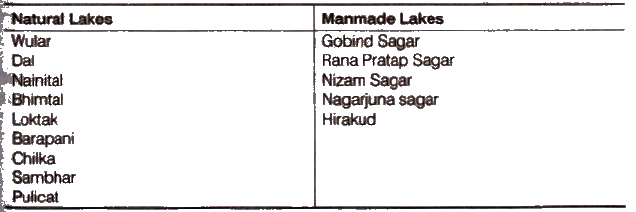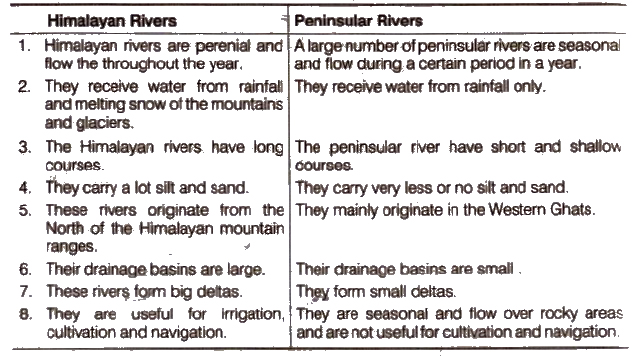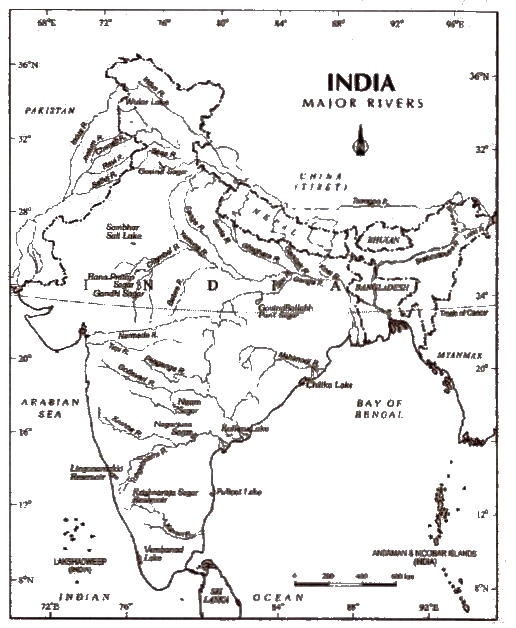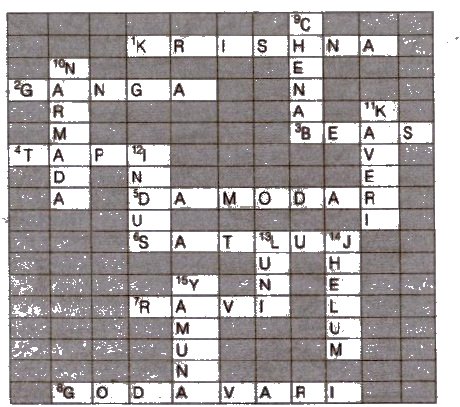NCERT Solutions for Class 9th Social Science Geography : Chapter 3: Drainage
Question 1. Choose the right answer from the four alternatives given below
(i) Which one of the following describes the drainage patterns resembling the branches of a tree?
(a) Radial
(b) Dendritic
(c) Centrifugal
(d) Trellis
Answer (b)
(ii) In which of the following states is the Wular Lake located ?
(a) Rajasthan
(b) Punjab
(c) Uttar Pradesh
(d) Jammu and Kashmir
Answer (d)
(iii) The river Narmada has its source as
(a) Satpura
(b) Amarkantak
(c) Brahmagiri
(d) Slopes of the Western Ghats
Answer (b)
(iv) Which one of the following lakes is a salt water lake?
(a) Sambhar
(b) Wular
(c) Dal
(d) Gobind Sagar
Answer (a)
(v) Which one of the following is the longest river of peninsular India?
(a) Narmada
(b) Krishna
(c) Godavari
(d) Mahanadi
Answer (c)
(vii) Which one amongst the following rivers flow through a Rift Valley?
(a) Mahanadi
(b) Krishna
(c) Tungabhadra
(d) Tapi
Answer (d)
Question 2. Answer the following questions briefly.
(i) What is meant by a water divide? Give an example
Answer Any elevated area such as a mountain or an upland that separate two drainage basins is called a water divide. An example are the Western Ghats.
(ii) Which is the largest river basin in India?
Answer The Ganga Basin is the largest river basin in India.
(iii) Where do the rivers Indus and Ganga have their origin?
Answer The river Indus rises in Tibet. near lake Mansarovar. and the Ganga originates at the Gangotri Glacier. Both of them have their origin in the Himalayas.
(iv) Name the two headstreams of the Ganga. Where do they meet to form the Ganga?
Answer The two head streams of the Ganga are the Bhagirathi and Alaknanda. They meet at Devprayag in Uttarakhand to form the Ganga.
(v) Why does the Brahmaputra in its Tibetan part have less silt, despite a longer course?
Answer In TIbet. the river Indus known as Tsang Po carries a smaller volume of water and less silt as it is a cold and dry area.
In India. the river carries a large volume of water and considerable amount of silt because it passes through a region of high rainfall.
(vi) Which two peninsular rivers flow through a trough ?
Answer Narmada and Tapi are two peninsular rivers, which flow through a trough.
(vii) State some economic benefits of rivers and lakes.
Answer Lakes
- Lakes are of a great value to human beings.
- Lakes help to regulate the flow of rivers.
- Lakes help to prevent flooding during rainy season.
- During the dry season, lakes help to maintain an even flow of water.
- Lakes can also be used for developing hydel power.
- They moderate the climate of the surroundings and maintain the aquatic ecosystem.
- They enhance natural beauty and help to develop tourism and provide recreation. e.g., Dal Lake and Naini Lake at Nainital.
- Lakes provide opportunities for fishery development.
Rivers
- They help to develop hydel power.
- They provide water for irrigation, for drinking and other requirements.
- They help to develop fisheries.
Question 3. Below are given names of a few lakes of India. Group them under two categories natural and created by human beings.

Answer

Question 4. Discuss the significant difference between the Himalayan and the peninsular rivers.
Answer Difference between the Himalayas and Peninsular rivers are as follows

Question 5. Compare the east flowing and west flowing rivers of the Peninsular plateau.
Answer The difference between east flowing rivers and west flowing rivers are

Question 6. Why are rivers important for the country’s economy?
Answer Rives are important for the country’s economy because water from the rivers is a basic natural resource essential for various human activities. These are
- The rivers provide water for irrigation.
- They provide fertility to the soil.
- They are useful for navigation
- They help to generate hydro-electricity.
- They help to develop tourism.
- They provide water for various domestic uses.
- They provide livelihood to fishermen.
- They help to moderate the climate and environment of nearby areas.
Map Skills
- On an outline map of India mark and label the following rivers Ganga, Satluj, Damodar, Krishna, Narmada, Tapi, Mahanadi and Brahmaputra.
- On an outline map of India mark and label the following lakes Chilika, Sambhar, Wular, Pulicat, Kolleru,
Answer

Project / Activity
Solve this crossword puzzle with the help of given cluses.
Across
- Nagarjuna Sagar is a river valley project. Name the river.
- The longest river of India.
- The river which originates from a place known as Beas Kund.
- The river which rises in the Betul district of MP and flows westwards.
- The river which is known as the ‘Sorrow’ of West Bengal.
- The river on which the reservoir for Indira Gandhi Canal has been built.
- The river whose source lies near Rohtang Pass.
- The longest river of peninsular India.
Down
- A Tributary of Indus originating from Himachal Pradesh.
- The river flowing through fault. drains into the Arabian Sea.
- A river of South India. which receives rain water both in summer and winter.
- A river which flows through Ladakh, Gilgit and Pakistan.
- An important river of the Indian desert.
- The river which joins Chenab in Pakistan
- A river which rises at Yamunotri Glacier.
Answer

Go Back to NCERT Solutions Social Science Page Maths English Science
To start your test
register with us:
To start
your test, registered user must login with their User Name & Password: